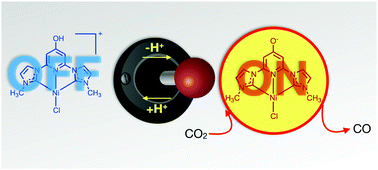当前位置:
X-MOL 学术
›
Chem. Commun.
›
论文详情
Our official English website, www.x-mol.net, welcomes your feedback! (Note: you will need to create a separate account there.)
Nickel(ii) pincer complexes demonstrate that the remote substituent controls catalytic carbon dioxide reduction†
Chemical Communications ( IF 4.9 ) Pub Date : 2018-03-13 00:00:00 , DOI: 10.1039/c7cc09507d Dalton B. Burks 1, 2, 3, 4 , Shakeyia Davis 4, 5, 6, 7, 8 , Robert W. Lamb 4, 9, 10, 11 , Xuan Liu 4, 6, 12, 13 , Roberta R. Rodrigues 4, 5, 6, 7, 8 , Nalaka P. Liyanage 4, 5, 6, 7, 8 , Yujie Sun 4, 6, 12, 13 , Charles Edwin Webster 4, 9, 10, 11 , Jared H. Delcamp 4, 5, 6, 7, 8 , Elizabeth T. Papish 1, 2, 3, 4
Chemical Communications ( IF 4.9 ) Pub Date : 2018-03-13 00:00:00 , DOI: 10.1039/c7cc09507d Dalton B. Burks 1, 2, 3, 4 , Shakeyia Davis 4, 5, 6, 7, 8 , Robert W. Lamb 4, 9, 10, 11 , Xuan Liu 4, 6, 12, 13 , Roberta R. Rodrigues 4, 5, 6, 7, 8 , Nalaka P. Liyanage 4, 5, 6, 7, 8 , Yujie Sun 4, 6, 12, 13 , Charles Edwin Webster 4, 9, 10, 11 , Jared H. Delcamp 4, 5, 6, 7, 8 , Elizabeth T. Papish 1, 2, 3, 4
Affiliation

|
The first example of a CNC pincer ligand with a central pyridinol ligand is reported in a nickel(II) complex. This metal complex can be protonated or deprotonated reversibly in situ to switch on or off the photocatalytic performance towards CO2 reduction. The O− substituent appears essential for catalysis.
中文翻译:

镍(ii)钳形络合物表明,远程取代基可控制二氧化碳的催化还原作用†
在镍(II)配合物中报道了具有中心吡啶吡啶配体的CNC钳形配体的第一个例子。该金属络合物可以原位可逆地质子化或去质子化,以开启或关闭朝向CO 2还原的光催化性能。将O -取代基出现催化关键。
更新日期:2018-03-13
中文翻译:

镍(ii)钳形络合物表明,远程取代基可控制二氧化碳的催化还原作用†
在镍(II)配合物中报道了具有中心吡啶吡啶配体的CNC钳形配体的第一个例子。该金属络合物可以原位可逆地质子化或去质子化,以开启或关闭朝向CO 2还原的光催化性能。将O -取代基出现催化关键。


























 京公网安备 11010802027423号
京公网安备 11010802027423号